OM System OM-5 Review
A very capable everyday, travel or sightseeing companion.
















Verdict
A lightweight, reasonably affordable yet reassuringly durable mirrorless camera that offers an enticing balance of portability, creativity and, moreover, quality.
The OM-5 is notable in being the first camera from the former Olympus to bear its new ‘OM System’ branding. It would be a shame if it’s overlooked due to this opaque branding as this is a capable contender for anyone looking to trade up from smartphone snapping to more considered photography. The OM-5 is a mid-range, everyday camera that offers everything all but the most fastidious of photo enthusiasts might want.
Pros
- Compact proportions yet rock solid construction
- Comprehensive features and intuitive hands-on control via top plate dials
- Great results straight out of the camera with minimum fuss
Cons
- The compact build is due in part to a physically smaller Four Thirds sensor
- Those with larger hands/fingers may find the OM-5’s control layout a little crammed
- Not as much support from third parties for add-on accessories
Key Features
- Compact, pocket friendly buildWith very manageable 366g body-only weight
- Four Thirds format sensorUnique to OM System and original development partner Panasonic
- 20.4MP stillsAnd up to 4K resolution video
- Body integral five-axis image stabilisation mechanismProvides up to a 7.5-stop equivalence
Introduction
While the connection might not be immediately obvious to anyone who has not previously owned a film-era OM series SLR, ‘OM System’ is the former Olympus camera division under new ownership. The rather opaque re-branding occurred a couple of years back, yet happily the products that have emerged since have maintained the same quality and performance we’d have expected from its former owner.
Whichever trading name they’re now being released under, these mirrorless compact system cameras – the OM-5 here included – have always been some of the most lightweight and portable interchangeable lens models available. That’s largely due to the incorporation of a Four Thirds sensor that is physically smaller at 17.3x13mm than the APS-C or Full Frame sensors used by rival manufacturers.
Though the rule of thumb is the bigger the sensor the more pixels can be competently crammed onto it, and so theoretically the better the resultant image, the set-up here has enabled a shorter distance between the sensor and lens mount. A quirk (or benefit) to this system is that whichever lens is attached provides a 35mm equivalence of double whatever is inscribed on the lens barrel. For example, attaching the OM System 12-40mm f/2.8 II Pro zoom lens we had in for testing alongside our OM-5 camera body gives us the equivalent of what would be a 24-80mm reach on a 35mm camera.
This, in theory, ensures that our camera and lens combination should be as adept at shooting wide angle landscapes as it is portraits and close-ups. While it’s not quite the super telephoto zoom for dedicated sports or wildlife photography, the focal range very much makes it a jack-of-all-trades.
The OM System OM-5 appears a sound choice for anyone trading up from shooting on their smartphone to a dedicated digital camera for the first time. The large flip-out screen at the back should offer familiar, intuitive operation for anyone who doesn’t want to fiddle around with this camera’s otherwise enticingly tactile operational buttons and dials. That’s the theory, but how about in practice?
Design and Handling
- 125x85x50mm body dimensions
- 366g body-only weight is comparable to a point-and-shoot compact
- 3-inch flip-out touchscreen with a 1,040,000-dot resolution
With an attractively retro exterior resembling a shrunken old-school SLR, the OM-5 is recognisably smaller and more manageable when held in the palm than competing manufacturers’ cameras housing physically larger APS-C and Full Frame-sized sensors.
Here the OM System camera’s physically more diminutive Four Thirds sensor is encased within a robust-to-the-touch body. Potential purchasers have the choice of silver or completely black exterior.
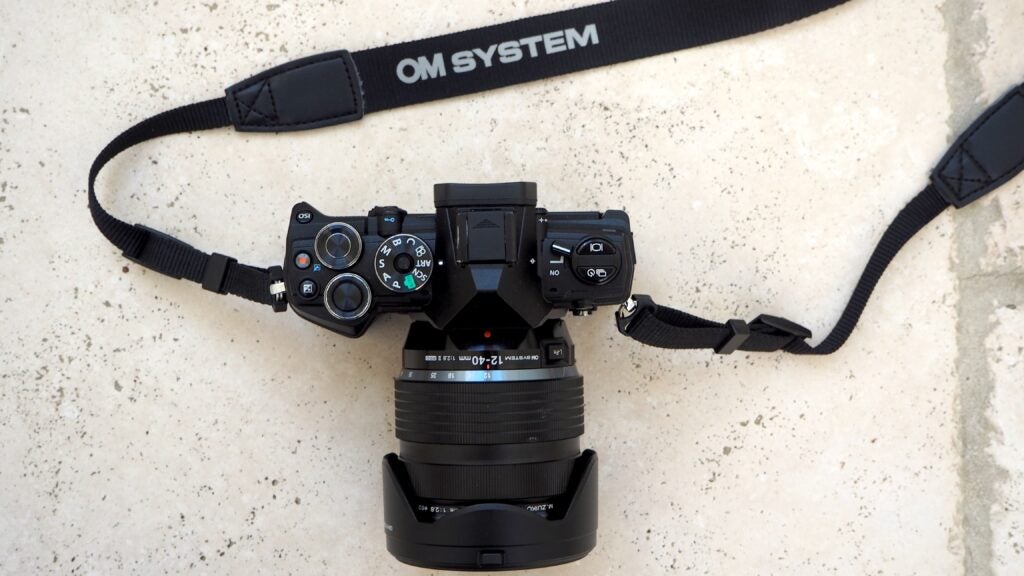
As noted in the intro, the build and performance quality of Olympus mirrorless cameras has always been high. Though the OM-5 now has ‘OM System’ etched above its lens mount, this weatherproofed splash-, dust- and freeze-resistant camera proves no exception.
Picking it up, the palm-sized body feels unusually lightweight at 366g without the lens attached – so much so that I thought I must have forgotten to insert the battery when I hadn’t. That said, the OM-5 exterior is of high-quality construction.
It has no give to it and feels reassuringly solid in use, with the busy array of top plate dials, in lieu of any control dials on the handgrip, having just the right amount of ‘give’ to them.
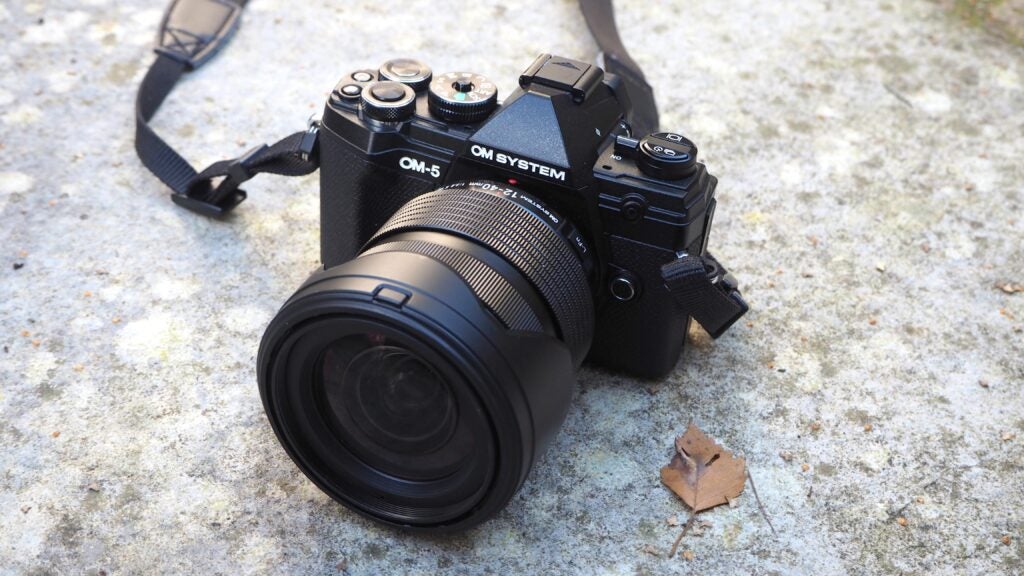
As well as helping avoid neck injury or back strain, the jacket pocket-sized design and low weight of this model make it a perfect companion for landscape, travel and street photography; I’m simply more likely to take it out and about with me as an ‘everyday camera’ than a heavier or bulkier alternative.
There’s a little compromise to be made when comparing the OM System OM-5 to an SLR or higher-end mirrorless rival, as well. Operational response times are swift enough that once I’ve imagined an intended composition in my mind’s eye, I am more than likely going to be able to quickly frame and capture it before my subject has moved on.
Yes, it is possible to just point and shoot with this camera and achieve excellent results. And yet the rangefinder-like top plate dials and switches on the OM-5 will hold extra appeal for those who want to get hands-on and exert a degree of manual control over their image-making as their confidence and skill set grows.
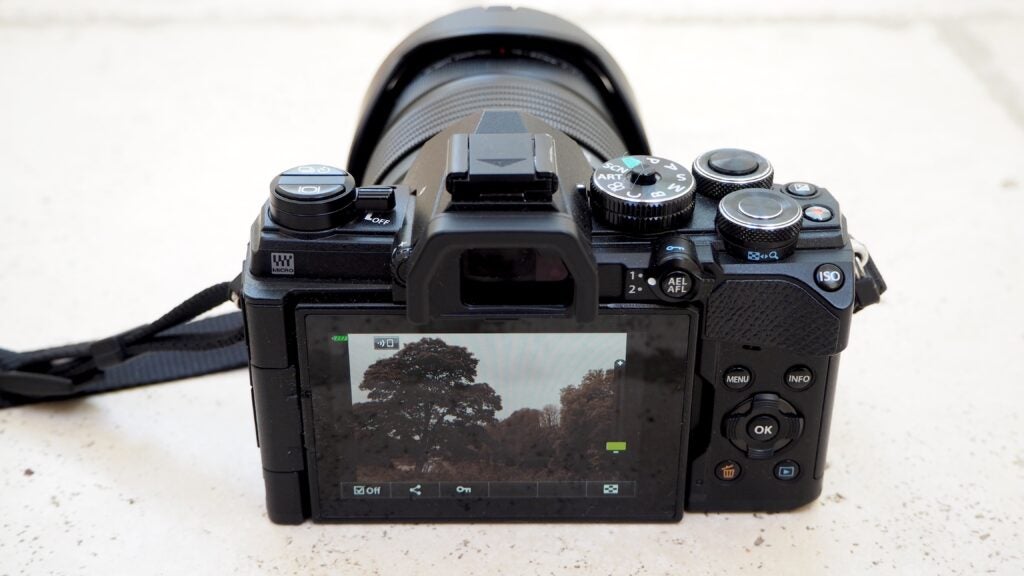
If I have one criticism that may put off absolute beginners it’s that the camera’s top plate is fairly crammed, with not a lot of room for the fat-fingered to turn dials and changes.
As this camera majors on its compactness overall, the OM-5’s handgrip isn’t particularly prominent either. I found that there’s just enough room to get a couple of fingers around it at the front, while a forefinger hovers over the raised shutter release button and my thumb rests on a leather effect promontory at the back. I was therefore able to hold the camera steady enough for my liking.
Attaching the lens adds to overall heft, while the provided neck strap also can help steady the camera if held at full stretch.
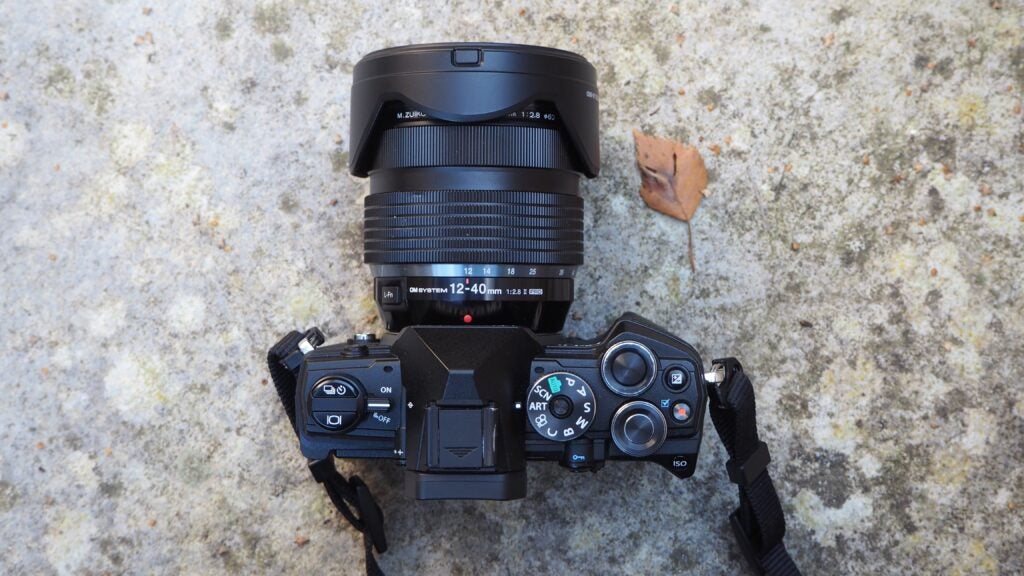
Sticking with the positives, the camera is attractively tactile and once gripped, it’s hard to keep fingers from wandering over to a particular dial or button to effect some change in setting or other.
The camera feels comfortable in the palm when walking around capturing subjects and, if and when you do want to move beyond pointing and shooting, the OM System OM-5 is not a camera to get bored of too quickly or easily.
Features
- Internal anti-shake system provides the equivalent of 7.5 stops with compatible lenses
- Up to 50MP still images achievable via 50MP Handheld High Res Shot option
Like other cameras in the OM System range and the outwardly near-identical Olympus mirrorless models that came before it, the 20 effective megapixel OM-5 features the ability to boost its resolution further.
The camera can construct up to 50-megapixel images from a composite series of shots via its Handheld High Res Shot option – a feature that at one time would have definitely required a tripod in support.
Here the camera offers up to the equivalent of 7.5EV steps of body-integral image stabilisation with a compatible lens thanks to the competency of its built-in five-axis image stabiliser. This means that any lens, such as the one we were using, becomes immediately stabilised and protects against the blurring effects of camera shake when attached.
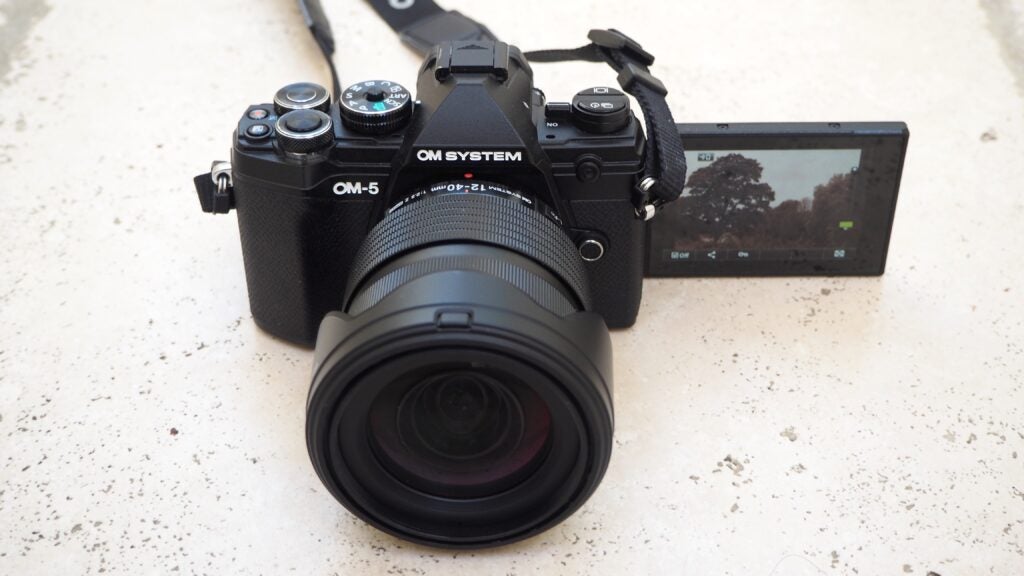
With a nod to those who wish to share footage between a camera and a smartphone, support for vertical video playback on smartphones is provided, as it is on the OM-1 Mark II higher up the range.
Otherwise, the OM-5 supports up to 4K resolution video shooting and compatibility with separately available accessories, including an ECG-5 External Grip for power users plus a RM-WR1 Wireless Remote Control, should one be required.
Of course, investing in an OM-5 if you don’t own any of the previous similar models to bear the Olympus branding, including its once popular PEN range, isn’t just about investing in the camera body itself but is really about investing in a system. That’s one thing the new OM System name does at least successfully allude to.
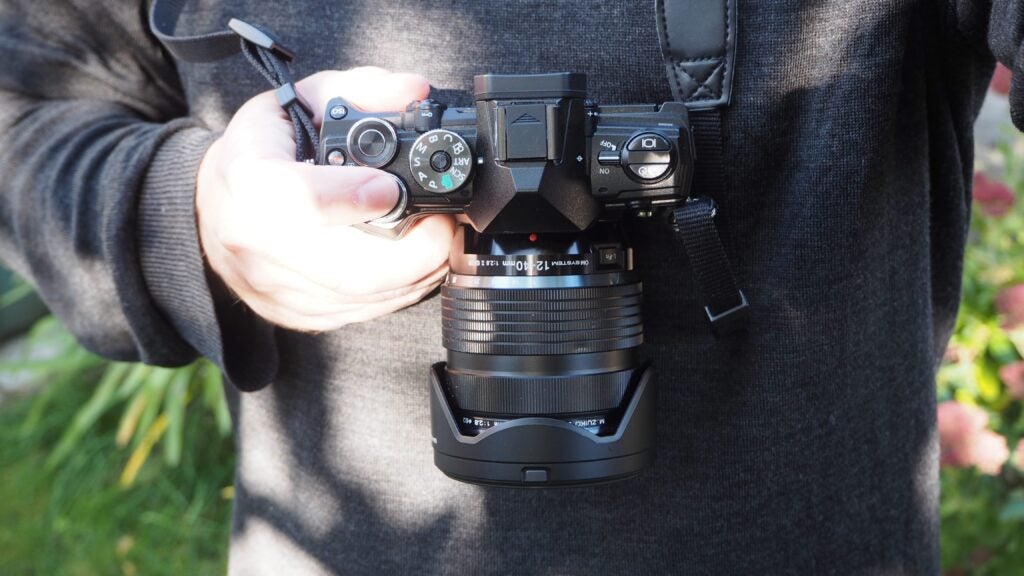
The fact that the OM-5 is more of an enthusiast’s camera than a professional-grade example is indicated by the fact that there is just a single memory card slot for the commonly used SD card.
Given the level of spec on offer and the achievable price point, that’s perfectly fine by us. Power users who like the look and sound of the OM system are instead directed to the two slots provided by the very capable flagship OM-1 Mark II in the same manufacturer’s range, even if that does inevitably result in a price hike.
Image Quality
- 20MP stills photography
- 30fps high speed continuous shooting video electronic shutter, or 10fps utilising mechanical shutter
- 4K resolution video at up to 30fps, or Full HD clips at a slow motion inducing 120fps
I am used to images from OM System/Olympus cameras being photo-realistic from the get-go, with rarely any adjustments required, save for perhaps a tweak to contrast and, very occasionally, to colour saturation.




That said, there is the option to dial in more vivid and dramatic tones in-camera as regards the latter. On-board digital Art Filters can be deployed here, given their own setting on the large and obvious shooting mode dial.
This includes the self-explanatory Pop Art filter. I found that when used in moderation, this filter can give a warmer more saturated boost to what otherwise might resemble dull colours, especially on an overcast day.




Whereas when it comes to the automatic compression of JPEGs, most digital cameras will offer Small, Medium or Fine options.
While the latter setting is ostensibly the default here, the OM-5 goes ‘one louder’ in practice, offering a maximum quality, least compression Super Fine JPEG option. This is just one step below the choice of going for a non-compressed maximum file size Raw. If you want optimal everyday results without quickly filling up your card with more data-hungry Raw files, then Super Fine is the way to go, delivering richly detailed results with plenty of realistic colour tones.
Latest deals
Should you buy it?
You want a creatively powerful, portable and intuitive-to-use camera
The OM-5 is a creatively powerful, portable and intuitive-to-use camera with the ability to switch lenses for optimal capture of any subject, and one that will neither break your back nor the bank. It’s a very capable everyday, travel or sightseeing companion.
You want plenty of third-party accessory options
If you want a large array of options from third-party manufacturers when it comes to affordable lenses and accessories the likes of Fuji, Sony, Nikon and Canon are better ways to go.
Final Thoughts
The OM System OM-5 has two jobs to do: be approachable enough to tempt smartphone users to invest in a mirrorless camera system and satisfy enthusiast photographers ditching a DSLR by offering much the same feature set and operation they’re already used to. On both counts, I think this camera largely succeeds.
It’s a shame then that, with the loss of Olympus branding from the front of these cameras, the ‘OM System’ has lost decades of hard-won brand recognition and visibility. This puts them at a disadvantage in comparison with close competitors, including Fujifilm’s X-series mirrorless range (such as the X-S20 or X-T50), which are also reasonably compact while featuring a larger APS-C-sized sensor. You can find more great alternatives in our guide to the best cameras.
Still, for those willing to go against the grain and investigate further the OM-5 is a capable all-rounder that should reward and satisfy curious users with years of faithful use.
How we test
We test every camera we review thoroughly. We use set tests to compare features properly and we use it as our main device over the review period. We’ll always tell you what we find and we never, ever, accept money to review a product.
Every camera we review is used for at least a week
All of the key features are tried and tested in real-world settings
FAQs
The OM-5 includes a 20.4MP Micro Four Thirds sensor.
The OM System OM-5 includes one SD card slot.







